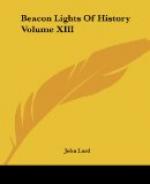“With prudes for
proctors, dowagers for deans,
And sweet girl-graduates
in their golden hair,”
it is Lady Psyche’s child that is the true, effective heroine of the story, as Dr. Dawson aptly points out. “Ridiculous in the lecture room, the babe in the poem, as in the songs, is made the central point upon which the plot turns, for the unconscious child is the concrete embodiment of Nature herself, clearing away all merely intellectual theories by her silent influence.” This is the explanation, then, of the appearance of the babe—symbol of the power and tenderness of Nature—in critical passages of the poem, as well as in the unsurpassably beautiful intercalary songs, for it is the child that enables the poet to soften the Princess’s nature toward the Prince, and to effect the reconciliation between the Princess and Lady Psyche, while imparting beauty as well as high meaning in the recital of the incidents and development of the tale.
“In Memoriam,” as we have stated, appeared in 1850, and was unique in its appeal to the mind of the era as a stately meditative poem on a single theme,—the death of the poet’s friend, Arthur Hallam. The English language, if we except Milton’s ‘Lycidas’ and ’Hymn to the Nativity,’ and Wordsworth’s grand ‘Ode on Intimations of Immortality,’ has no poem so noble or so faultless in its art as this magnificent series of detached elegies. The high thought, philosophic reflection, and passionate religious sentiment that mark the whole work, added to the exquisiteness of the versification, place it wellnigh supreme in the literature of elegiac poetry. Its grave, majestic hymnal measure adds to its solemn beauty and stateliness, while the varied phases of spiritualized thought and emotional grief which find expression in the poem seem to elevate it in its harmonies to the rank of a profound psalm-chant from the choir of heaven. In the sumptuously embellished edition of the elegy, embodying Mr. Harry Fenn’s drawings, with a sympathetic preface by the Rev. Dr. Henry Van Dyke, there is a brief but luminous analysis of the nine divisions of the poem, or commentary on the great classic. To those who desire to read the great elegy understandingly, the value of Dr. Van Dyke’s work is earnestly commended, since without this commentary, or such as are to be obtained in other critical sources, there is much of poetic beauty, of sorrow-brooding thought, and especially of emotional reflection on life, death, and immortality, in the hundred and thirty lyrics of which the poem consists, which will be lost to even the thoughtful reader. The poem, as a critic truthfully observes, has done much “to express and to consolidate all that is best in the life of England, its domestic affection, its patriotic feeling, its healthful morality, its rational and earnest religion.”




